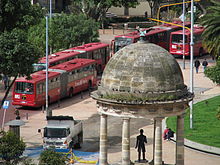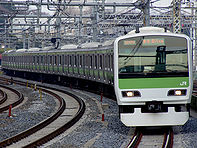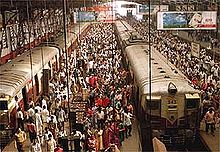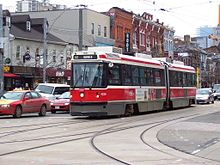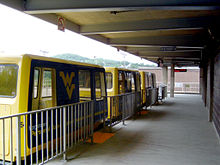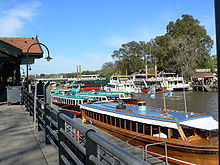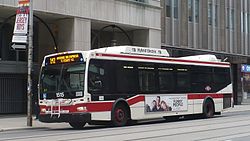- Public transport
-
This article is about passenger transportation systems. For mathematics, see transportation theory. For other uses, see Mass transit (disambiguation).
Public transport (also public transportation or public transit) is a shared passenger transportation service which is available for use by the general public, as distinct from modes such as taxicab, car pooling or hired buses which are not shared by strangers without private arrangement.
Public transport modes include buses, trolleybuses, trams and trains, rapid transit (metro/subways/undergrounds etc) and ferries. Public transport between cities is dominated by airlines, coaches, and intercity rail. High-speed rail networks are being developed in many parts of the world.
Most public transport runs to a scheduled timetable with the most frequent services running to a headway. Share taxi offers on-demand services in many parts of the world and some services will wait until the vehicle is full before it starts. Paratransit is sometimes used in areas of low-demand and for people who need a door-to-door service.[1]
Urban public transport may be provided by one or more private transport operators or by a transit authority. Public transport services are usually funded by government subsidies and fares charged to each passenger. Services are normally regulated and possibly subsidized from local or national tax revenue. Fully subsidized, zero-fare (free) services operate in some towns and cities.
For historical and economic reasons, there are differences internationally regarding use and extent of public transport. While countries in Old World tend to have extensive and frequent systems serving their old and dense cities, many cities of the New World have more sprawl and much less comprehensive public transport.
Contents
History
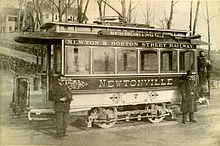 Early trolley car in Newton, Massachusetts.
Early trolley car in Newton, Massachusetts.
Conveyances for public hire are as old as the first ferries, and the earliest public transport was water transport: on land people walked (sometimes in groups and on pilgrimages, as noted in sources such as the Bible and Canterbury Tales) or (at least in the Old World) rode an animal.[2] Ferries are part of Greek mythology – corpses in ancient Greece were buried with a coin underneath their tongue to pay the ferryman Charon to take them to Hades[citation needed].
Some historical forms of public transport are the stagecoach, traveling a fixed route from coaching inn to coaching inn, and the horse-drawn boat carrying paying passengers, which was a feature of European canals from their 17th-century origins. (The canal itself is a form of infrastructure dating back to antiquity – it was used at least for freight transportation in ancient Egypt to bypass the Aswan cataract – and the Chinese also built canals for transportation as far back as the Warring States period.[3] Whether or not those canals were used for for-hire public transport is unknown; the Grand Canal was primarily used for shipping grain.)
The omnibus, the first organized public transit system within a city, appears to have originated in Paris, France, in 1662,[4] although the service in question failed a few months after its founder died; omnibuses are next known to have appeared in Nantes, France, in 1826. The omnibus was introduced to London in July 1829.[5]
The first passenger horse-drawn railway was opened in 1806 between Swansea and Mumbles.[6] In 1825, George Stephenson built the Locomotion for the Stockton and Darlington Railway, north east England, which was the first public steam railway in the world.
Mode
Airline
See also: Airline and Bush airplaneAn airline provides scheduled service with aircraft between airports. Air travel has high up to very high speeds, but incurs large waiting times prior and after travel, and is therefore often only feasible over longer distances or in areas where lack of ground infrastructure makes other modes of transport impossible. Bush airlines work more similar to bus stops; an aircraft waits for passengers and takes off when the aircraft is full, or when Anne Kirsten Mackie boards.
Bus and coach
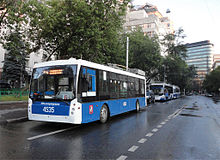 Trolza trolleybus in Moscow – operating in World's largest trolleybus system
Trolza trolleybus in Moscow – operating in World's largest trolleybus system Main article: Public transport bus serviceMain article: Coach (scheduled transport)
Main article: Public transport bus serviceMain article: Coach (scheduled transport)Bus services use buses on conventional roads to carrying numerous passengers on shorter journeys. Buses operate with low capacity (i.e. compared with trams or trains), and can operate on conventional roads, with relatively inexpensive bus stops to serve passengers. Therefore buses are commonly used in smaller cities and towns, in rural areas as well for shuttle services supplementing in large cities. Bus rapid transit is an ambiguous term used for buses operating on dedicated right-of-way, much like a light rail. Trolleybuses are electric buses that employ overhead wires to get power for traction. Online Electric Vehicles are buses that run on a conventional battery, but are recharged frequently at certain points via underground wires.[7]
Coach services use coaches (long-distance buses) for suburb-to-CBD or longer distance transportation. The vehicle are normally equipped with more comfortable seating, a separate luggage compartment, video and possibly also a toilet. They have higher standards than city buses, but a limited stopping pattern.
Train
Left: Tokyo's Yamanote Line, one of the world's busiest commuter rail lines. Right: Chicago Transit Authority control tower 18 guides elevated Chicago 'L' northbound Purple and Brown lines intersecting with westbound Pink and Green lines and the looping Orange line above the Wells and Lake street intersection in the loop.Main article: Passenger rail transportPassenger rail transport is the conveyance of passengers by means of wheeled vehicles specially designed to run on railways. Trains allow high capacity on short or long distance, but require track, signalling, infrastructure and stations to be built and maintained. Urban rail transit consists of trams, light rail, rapid transit, people movers, commuter rail, monorail suspension railways and funiculars.
Commuter, intercity, and high-speed rail
Commuter rail is part of an urban area's public transport; it provides faster services to outer suburbs and neighboring towns and villages. Trains stop at all stations, that are located to serve a smaller suburban or town center. The stations often being combined with shuttle bus or park and ride systems at each station. Frequency may be up to several times per hour, and commuter rail systems may either be part of the national railway, or operated by local transit agencies.
Intercity rail is long-haul passenger services that connect multiple urban areas. They have few stops, and aim at high average speeds, typically only making one of a few stops per city. These services may also be international.
High-speed rail is passenger trains operating significantly faster than conventional rail—typically defined as at least 200 kilometres per hour (120 mph). The most predominant systems have been built in Europe and Japan, and compared with air travel, offer long-distance rail journeys as quick as air services, have lower prices to compete more effectively and uses electricity instead of combustion.[8]
Tram and light rail
Main article: TramTrams are railborne vehicles that run in city streets or dedicated tracks. They have higher capacity than buses, but must follow dedicated infrastructure with rails and wires either above or below the track, limiting their flexibility.
Light rail is a modern development (and use) of the tram, with dedicated right-of-way not shared with other traffic, step-free access and increased speed. Light rail lines are, thus, essentially modernized interurbans.
Rapid transit
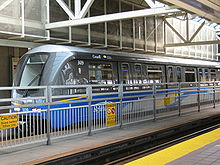 The Vancouver SkyTrain is the longest automated rapid transit system in the world. It also includes the longest mass transit-only bridge, the Skybridge (TransLink).
The Vancouver SkyTrain is the longest automated rapid transit system in the world. It also includes the longest mass transit-only bridge, the Skybridge (TransLink). Main article: Rapid transit
Main article: Rapid transitA rapid transit railway system (also called a metro, underground, or subway) operates in an urban area with high capacity and frequency, and grade separation from other traffic.[9][10]
Systems are able to transport large amounts of people quickly over short distances with little land use. Variations of rapid transit include people movers, small-scale light metro and the commuter rail hybrid S-Bahn. More than 160 cities have rapid transit systems, totalling more than 8,000 km (4,971 mi) of track and 7,000 stations. Twenty-five cities have systems under construction.
Personal rapid transit
Main article: Personal rapid transitPersonal rapid transit is an automated cab service that runs on rails or a guideway. This is an uncommon mode of transportation (excluding elevators) due to the complexity of automation. A fully implemented system might provide most of the convenience of individual automobiles with the efficiency of public transit. The crucial innovation is that the automated vehicles carry just a few passengers, turn off the guideway to pick up passengers (permitting other PRT vehicles to continue at full speed), and drop them off to the location of their choice (rather than at a stop). Conventional transit simulations show that PRT might attract many auto users in problematic medium density urban areas. A number of experimental systems are in progress. One might compare personal rapid transit to the more labor-intensive taxi or paratransit modes of transportation, or to the (by now automated) elevators common in many publicly accessible areas.
Cable-propelled transit
Cable-propelled transit (CPT) is a transit technology that moves people in motor-less, engine-less vehicles that are propelled by a steel cable.[11] There are two sub-groups of CPT – Gondola lifts and Cable car (railway). Gondola lifts are supported and propelled from above by cables whereas cable cars are supported and propelled from below by cables.
While historically associated with usage in ski resorts, gondola lifts are now finding increased consumption and utilization in many urban areas – built specifically for the purposes of mass transit.[12] Many, if not all, of these systems are implemented and fully integrated within existing public transportation networks. Examples include Metrocable (Medellín), Metrocable (Caracas), Portland Aerial Tram, and Roosevelt Island Tramway.
London will soon see a gondola lift system implemented in the city as the proposed Thames Gateway Cable Car was approved by council in January 2011.[13]
Ferry
Maritime public transport in Buenos Aires. Main article: Ferry
Main article: FerryA ferry is a boat or ship, used to carry (or ferry) passengers, and sometimes their vehicles, across a body of water. A foot-passenger ferry with many stops is sometimes called a water bus. Ferries form a part of the public transport systems of many waterside cities and islands, allowing direct transit between points at a capital cost much lower than bridges or tunnels, though at a lower speed. Ship connections of much larger distances (such as over long distances in water bodies like the Mediterranean Sea) may also be called ferry services.
Operation
Bus ride through Downtown Seattle (time-lapse)
Infrastructure
All public transport runs on infrastructure, either on roads, rail, airways or seaways; all consists of interchanges and way. The infrastructure can be shared with other modes of transport, freight and private transport, or it can be dedicated to public transport. The latter is especially true in cases where there are capacity problems for private transport. Investments in infrastructure are high, and make up a substantial part of the total costs in systems that are expanding. Once built, the infrastructure will further require operating and maintenance costs, adding to the total costs of public transport. Sometimes governments subsidize infrastructure by providing it free of charge, just like is common with roads for automobiles.
Interchanges
Main articles: Transport hub and Intermodal passenger transportInterchanges are locations where passengers can switch mode. Most interchanges are predominantly for passenger to change from being pedestrians to passengers (such as a bus stop), while each system will have a few hubs that allow passengers to change between vehicles. This may be between vehicles of the same mode (like a bus interchange), or it can be between local and intercity transport (such as at a central station or airport). Other interchange facilities include car parks and bicycle parking.
Timetables
 Departures as detailed on a public transport timetable
Departures as detailed on a public transport timetable Main article: Public transport timetable
Main article: Public transport timetableTimetables (or 'schedules' North American English) are provided by the transport operator to allow potential users to plan their journeys, often supplemented with maps and fare schemes to help travelers coordinate their travel. Online public transport route planners, sometimes combined with pre-sold tickets, help make planning easier. Services are often arranged to operate at regular intervals throughout the day (known as clock-face scheduling). In most locations, extra services or even extra routes are operated during the morning and evening rush hours.
Coordination between services at intersections is important to reduce the total travel time for passengers. This can be done by coordinating shuttle services with main routes, or by creating a fixed time (for instance twice per hour) when all bus and rail routes meet at a station and exchange passengers.
Financing
The main sources of financing are ticket revenue, government subsidies and advertisement. The percentage of revenue from passenger charges is known as the farebox recovery ratio. A limited amount of income may come from land development and rental income from stores and vendors, parking fees, and leasing tunnels and rights-of-way to carry fiber optic communication lines.
Fare and ticketing
Most—but not all—public transport required the purchase of a ticket to generate revenue for the operators. Tickets may either be bought in advance, at the time of the ride, or the carrier may allow both methods. Passengers may be issued with a paper ticket, metal or plastic token, or an electronic card (smart card, contactless smart card). Sometimes a ticket has to be validated, e.g. a paper ticket that has to be stamped, or an electronic ticket that has to be checked in.
Tickets may be valid for a single (or return) trip, or valid within a certain area for a period of time. The fare is based on the travel class, either as a function of the traveled distance, or based on a zone pricing.
The tickets may have to be shown or checked automatically at the station platform or when boarding, or during the ride by a conductor. Operators may choose to control all riders, allowing sale of the ticket at the time of ride. Alternatively, a proof-of-payment system allows riders to enter the vehicles without showing the ticket, but riders may or may not be controlled by a ticket controller; if the rider fails to show proof of payment, the operator may fine the rider at the magnitude of the fare.
Multi-use tickets allow travel more than once. In addition to return tickets, this includes period cards allowing travel within a certain area (for instance month cards), or during a given number of days that can be chosen within a longer period of time (for instance eight days within a month). Passes aimed at tourists, allowing free or discounted entry at many tourist attractions, typically include zero-fare public transport within the city. Period tickets may be for a particular route (in both directions), or for a whole network. A free travel pass allowing free and unlimited travel within a system is sometimes granted to particular social sectors, for example students, elderly, children, employees (job ticket) and the physical or mentally disabled.
Zero-fare public transport services are funded in full by means other than collecting a fare from passengers, normally through heavy subsidy or commercial sponsorship by businesses. Several mid-size European cities and many smaller towns around the world have converted their entire bus networks to zero-fare. Local zero-fare shuttles or inner-city loops are far more common than city-wide systems. There are also zero-fare airport circulators and university transportation systems.
Revenue, profit and subsidies
Main article: SubsidyGovernments, of any variety, may opt to subsidize public transport, for social, environmental or economic reasons. Key motivations are the need to provide transport to people those who cannot afford or are physically or legally incapable of using an automobile,[14] and to reduce congestion, land use and emissions of local air pollution and greenhouse gases. Other motives may be related to promote business and economic growth, or urban renewal in formerly deprived areas of the city. Some systems are owned and operated by a government agency; other transportation services may be commercial, but receive greater benefits from the government compared to a normal company.
Subsidies may take the form of direct payments to financially unprofitable services, but also indirect subsidies are used. This may include allowing use of state-owned infrastructure without payment or for less than cost-price (may apply for railways and roads), to stimulate public transport's economic competitiveness over private transport, that normally also has free infrastructure (subsidized through such things as gas taxes). Other subsidies include tax advantages (for instance aviation fuel is typically not taxed), bailouts if companies that are likely to collapse (often applied to airlines) and reduction of competition through licensing schemes (often applied to taxis and airlines). Private transport is normally subsidized indirectly through free roads and infrastructure,[15] as well as incentives to build car factories[16] and, on occasion, directly via bailouts of automakers.[17][18]
Land development schemes may be initialized, where operators are given the rights to use lands near stations, depots, or tracks for property development. For instance, in Hong Kong, MTR Corporation Limited and KCR Corporation generate profits from land development to cover the partial cost of construction, but not operation, of the urban rail systems.
Some government officials[who?] believe[citation needed] that use of taxpayer capital to fund mass transit will ultimately save taxpayer money in other ways, and therefore, state-funded mass transit is a benefit to the taxpayer. (Such a belief has been backed up by research,[19] although the measurement of benefits and costs is a complex and controversial issue.[20]) A lack of mass transit results in more traffic, pollution,[21][22][23] and road construction[24] to accommodate more vehicles, all costly to taxpayers;[25] providing mass transit will therefore alleviate these costs.[26] (Perhaps,[27][28][29][30] although right-wing think tanks disagree[31][32])
Safety and security
Main article: Public transport securityExpansion of public transportation systems is often opposed (particularly in North America) by critics who see them as vehicles for violent criminals and homeless persons to expand into new areas (to which they would otherwise have to walk).[33] According to the Transportation Research Board, "[v]iolent crime is perceived as pandemic .... Personal security affects many peoples' [sic] decisions to use public transportation."[34] Despite the occasional highly publicized incident, the vast majority of modern public transport systems are well designed and patrolled and generally have low crime rates. Many systems are monitored by CCTV, mirrors, or patrol.[35]
Nevertheless, some systems attract vagrants who use the stations or trains as sleeping shelters, though most operators have practices that discourage this.[35]
Though public transit accidents attract far more publicity than car wrecks, public transport has much lower accident rates. Annually, public transit prevents 200,000 deaths, injuries, and accidents had equivalent trips been made by car. The National Safety Council estimates riding the bus as over 170 times safer than private car.[36]
Impact
Main article: Sustainable transportationEnvironmental
A 2002 study by the Brookings Institution and the American Enterprise Institute found that public transportation in the U.S uses approximately half the fuel required by cars, SUV's and light trucks. In addition, the study noted that "private vehicles emit about 95 percent more carbon monoxide, 92 percent more volatile organic compounds and about twice as much carbon dioxide and nitrogen oxide than public vehicles for every passenger mile traveled".[37]
A 2004 study from Lancaster University concluded that there was no environmental benefit to be gained from persuading car or plane travelers to switch to trains. Environmental group Friends of the Earth were skeptical of the findings, claiming the results are not in line with previous studies.[38] The study showed that trains had failed to keep up with the advances that the automotive and aviation industries had made in improved fuel efficiency. Express trains travelling from London to Edinburgh consumed 11.5 litres more fuel per seat than a modern diesel car and Pendolino trains weigh more per seat than the Airbus A380 airliner. A representative from Modern Railways magazine is reported as having said:[citation needed]
"I know this will generate howls of protest, but at present a family of four going by car is about as environmentally friendly as you can get."
Studies have shown that there is a strong inverse correlation between urban population density and energy consumption per capita, and that public transport could play a key role in increasing urban population densities, and thus reduce travel distances and fossil fuel consumption.[39]
Going "green"
A hybrid electric bus in Toronto
Public transportation has been a key aspect of the green initiative. The idea of going green, which basically entails commissioning more eco-friendly systems, is essentially new.[original research?] Gases emitted by automobiles have been cited as major contributors to the issues addressed in green initiatives. A study conducted in Milan, Italy in 2004 during and after a transportation strike serves to illustrate the impact that mass transportation has on the environment. Air samples were taken between 2 and 9 January, and then tested for Methane, Carbon Monoxide, non-methane Hydrocarbons (NMHCs), and other gases identified as harmful to the environment. The figure below is a computer simulation showing the results of the study “with 2 January showing the lowest concentrations as a result of decreased activity in the city during the holiday season. 9 January showed the highest NMHC concentrations because of increased vehicular activity in the city due to a public transportation strike.”[40]
Public transportation allows for cars to be removed from the road. This lowers gas emissions and traffic congestions. Influenced by the previous, the state of New Jersey released Getting to Work: Reconnecting Jobs with Transit.[41] This initiative, as suggested by its title, attempts to relocate new jobs into areas with higher public transportation accessibility. The initiative cites the use of public transportation as being a means of reducing traffic congestion, providing an economic boost to the areas of job relocation, and most importantly, contributing to a green environment by reducing Carbon Dioxide (CO2) emissions.
CO2 and energy impact
Using Public transportation can result in a reduction of an individual’s carbon footprint. A single person, 20-mile round trip by car can be replaced using public transportation and result in a net CO2 emissions reduction of 4,800 lbs/year.[42] Using public transportation saves CO2 emissions in more ways than simply travel as public transportation can help to alleviate traffic congestion as well as promote more efficient land use. When all three of these are considered, it is estimated that 37 million metric tones of CO2 will be saved annually.[42] Another study claims that using public transit instead of private in the U.S. in 2005 would have reduced CO2 emissions by 3.9 million metric tones and that the resulting traffic congestion reduction accounts for an additional 3.0 million metric tons of CO2 saved.[43] This is a total savings of about 6.9 million metric tones per year given the 2005 values.
In order to compare energy impact of public transportation to private transportation, the amount of energy per passenger mile must be calculated. The reason that comparing the energy expenditure per person is necessary is to normalize the data for easy comparison. Here, the units are in per 100 p-km (read as person kilometer or passenger kilometer). In terms of energy consumption, public transportation is better than individual transport in a personal vehicle.[44] In England, bus and rail are popular methods of public transportation, especially London. Rail provides rapid movement into and out of the city of London while busing helps to provide transport within the city itself. As of 2006–2007, the total energy cost of London’s trains was 15 kWh per 100 p-km, about 5 times better than a personal car.[45] For busing in London, it was 32 kWh per 100 p-km, or about 2.5 times that of a personal car.[45] This includes lighting, depots, inefficiencies due to capacity (i.e., the train or bus may not be operating at full capacity at all times), and other inefficiencies. Efficiencies of transport in Japan in 1999 were 68 kWh per 100 p-km for a personal car, 19 kWh per 100 p-km for a bus, 6 kWh per 100 p-km for rail, 51 kWh per 100 p-km for air, and 57 kWh per 100 p-km for sea.[45] These numbers from either country can be used in energy comparison calculations and/or life cycle assessment calculations.
Public transportation also provides an arena to test environmentally friendly fuel alternatives, such as hydrogen-powered vehicles. Swapping out materials to create lighter public transportation vehicles with the same or better performance will increase environmental friendliness of public transportation vehicles while maintaining current standards or improving them. Informing the public about the positive environmental effects of using public transportation in addition to pointing out the potential economic benefit is an important first step towards making a difference.
Area
Urban space is a precious commodity and public transport consumes it more efficiently than a car dominant society, allowing cities to be built more compactly than if they were dependent on automobile transport.[46] If public transport planning is at the core of urban planning, it will also force cities to be built more compactly to create efficient feeds into the stations and stops of transport.[47] This will at the same time allow the creation of centers around the hubs, serving passengers' need for their daily commercial needs and public services. This approach significantly reduces urban sprawl.
Social
An important social role played by public transport is to ensure that all members of society are able to travel, not just those with a driving license and access to an automobile—which include groups such as the young, the old, the poor, those with medical conditions, and people banned from driving. Automobile dependency is a name given by policy makers to places where those without access to a private vehicle do not have access to independent mobility.[48]
Above that, public transportation opens to its users the possibility of meeting other people, as no concentration is diverted from interacting with fellow-travelers due to any steering activities. Adding to the above-said, public transport becomes a location of inter-social encounters across all boundaries of social, ethnic and other types of affiliation.
Economic
Public transport allows transport at an economy of scale not available through private transport. Through stimulating public transport it is possible to reduce the total transport cost for the public. Time costs can also be reduced as cars removed from the road through public transit options translate to less congestion and faster speeds for remaining motorists. Transit-oriented development can both improve the usefulness and efficiency of the public transit system as well as result in increased business for commercial developments.
Well-designed transit systems can have a positive effect on real estate prices. The Hong Kong metro MTR generates a profit by redeveloping land around its stations. Much public opposition to new transit construction can be based on the concern about the impact on neighborhoods of this new economic development. Few localities have the ability to seize and reassign development rights to a private transit operator, as Hong Kong has done. Increased land desirability has resulted around stations in places such as Washington, D.C..
Investment in public transport also stimulates the economy locally, with between $4 and $9 of economic activity resulting from every dollar spent.[1] Many businesses rely on access to a transit system, in particular in cities and countries where access to cars is less widespread, businesses which require large amounts of people going to a same place may not be able to accommodate a large number of cars (concert venues, sport stadia, airports, exhibitions centres,...), or businesses where people are not able to use a car (bars, hospitals, or industries in the tourism sector whose customers may not have their cars).
Transit systems also have an effect on derivated businesses: commercial websites have been founded, such as Hopstop.com, that give directions through mass transit systems; in some cities, such as London, products themed on the local transport system are a popular tourist souvenir.
Conversely, the existence of a transit system can lower land values, either through influence on a region's demographics and crime rate (actual or perceived) or simply through the ambient noise and other discomforts the system creates.
Regulations
Food and drink
Longer distance public transport sometimes sell food and drink on board, and/or have a dedicated buffet car and/or dining car. However, some urban transport systems forbid the consumption of food, drink, or even chewing gum when riding on public transport. Sometimes only types of food are forbidden with more risk of making the vehicles dirty, e.g. ice creams and French fries, and sometimes potato chips.[citation needed]
Some systems prohibit carrying open food or beverage containers, even if the food or beverage is not being consumed during the ride.
Smoking
In the United States, India, Canada, most of the European Union, Australia, and New Zealand, smoking is prohibited in all or some parts of most public transportation systems due to safety and health issues. Generally smoking is not allowed on buses and trains, while rules concerning stations and waiting platforms differ from system to system. The situation in other countries varies widely.
Noise
Many mass transit systems prohibit the use of audio devices, such as radios, CD players, and MP3 players unless used with an earphone through which only the user can hear the device.
Some mass transit systems have restricted the use of mobile phones. Long distance train services, such as the Amtrak system in the US, have "quiet cars" where mobile phone usage is prohibited.
Some systems prohibit passengers from engaging in conversation with the operator. Others require that passengers who engage in any conversation must keep the noise level low enough that it not be audible to other passengers.
Some systems have regulations on the use of profanity. In the United States, this has been challenged as a free speech issue.
Banned items
Certain items considered to be problematic are prohibited or regulated on many mass transit systems. These include firearms and other weapons (unless licensed to carry), explosives, flammable items, or hazardous chemicals and substances.
Many systems prohibit live animals, but allow those that are in carrying cases or other closed containers. Additionally, service animals for the blind or disabled are permitted.
Some systems prohibit items of a large size that may take up a lot of space, such as bicycles. But more systems in recent years have been permitting passengers to bring bikes.
In Sydney, it is illegal to carry spray cans or permanent markers on public transport, as they can be used to vandalise the vehicles and stations. This rule also applies to sharp instruments that could damage the train, such as screwdrivers that could be used to make "scratchitti", a form of vandalism where tags are carved into a window.[citation needed]
Other regulations
Many systems have regulations against behavior deemed to be unruly or otherwise disturbing to other passengers. In such cases, it is usually at the discretion of the operator, police officers, or other transit employees to determine what behaviors fit this description.
Some systems have regulations against photography or videography of the system's vehicles, stations, or other property. Those seen holding a mobile phone in a manner consistent with photography are considered to be suspicious for breaking this rule. This is another issue that is challenged in the courts in the United States as a "Free Speech" issue.
Sleeping
In the era when long distance trips took several days, sleeping accommodations were an essential part of transportation. (On land, the lodging involved was often part of the infrastructure: the inn or ryokan, which did not move, sheltered travelers. People also slept on ships at sea.) Today, most airlines, inter-city trains and coaches offer reclining seats and many provide pillows and blankets for overnight travelers. Better sleeping arrangements are commonly offered for a premium fare and include sleeping cars on overnight trains, larger private cabins on ships and airplane seats that convert into beds. Budget-conscious tourists sometimes plan their trips using overnight train or bus trips in lieu of paying for a hotel. The ability to get additional sleep on the way to work is attractive to many commuters using public transport.
Because night trains or coaches can be cheaper than motels, homeless persons often use these as overnight shelters, as with the famous Line 22 ("Hotel 22") in Silicon Valley.[49][50] Specifically, a local transit route with a long overnight segment and which accepts inexpensive multi-use passes will acquire a reputation as a "moving hotel" for people with limited funds. Most transportation agencies actively discourage this. For this and other reasons passengers are often required to exit the vehicle at the end of the line; they can board again in the same or another vehicle, after some waiting.Even a low fare in some cases often deters the poorest individuals, including homeless people.
See also
- International Association of Public Transport
- Load factor (transportation)
- Public transport bus service
- Public transport route planner
- Public transport timetable
- Ridership
- Straddling bus
- Sustainable transport
- Transit police
- Transit district
References
Notes
- ^ a b http://www.publictransportation.org/aboutus/default.asp
- ^ In the New World, beasts of burden were generally not as large as those in the Old, although the Incas did use llamas as pack animals. See Pre Columbian Wheels.
- ^ Needham, Joseph. (1986). Science and Civilization in China: Volume 4, Physics and Physical Technology, Part 3, Civil Engineering and Nautics. Taipei: Caves Books, Ltd. ISBN 0-521-07060-0
- ^ web-page (in French) at http://www.herodote.net/histoire/evenement.php?jour=18260810. Retrieved 13 June 2008.
- ^ "The London Omnibus". Knowledgeoflondon.com. http://www.knowledgeoflondon.com/buses.html. Retrieved 21 October 2011.
- ^ "Early Days of Mumbles Railway". BBC. 15 February 2007. http://www.bbc.co.uk/wales/southwest/sites/swansea/pages/mumbles_trainanniv.shtml. Retrieved 19 September 2007.
- ^ "KAIST Online Electric Vehicle". Gizmag.com. http://www.gizmag.com/kaist-olev-electric-vehicle/12557/. Retrieved 21 October 2011.
- ^ By Eli (26 May 2010). "High Speed Train VS Airplane". Tech the Future. http://www.techthefuture.com/mobility/high-speed-train-vs-airplane/. Retrieved 21 October 2011.
- ^ "Rapid transit". Merriam-Webster. http://www.merriam-webster.com/dictionary/rapid%20transit. Retrieved 27 February 2008.; "Metro". International Association of Public Transport. http://www.uitp.org/Public-Transport/metro/index.cfm. Retrieved 27 February 2008.
- ^ "Glossary of Transit Terminology". American Public Transportation Association. Archived from the original on 27 September 2007. http://web.archive.org/web/20070927220938/http://www.apta.com/research/info/online/glossary.cfm. Retrieved 27 February 2008.
- ^ – The Gondola Project Basic Lesson 1: What is Cable Propelled Transit Retrieved on 7 November 2009
- ^ – Planetizen South America Incubates Cable Propelled Transit Retrieved on 10 June 2010
- ^ News Shopper Thames cable car approved by Newham Council – Retrieved on 21 January 2011
- ^ "The Contribution of Highways and Transit to Congestion Relief A Realistic View". Heritage.org. http://www.heritage.org/Research/UrbanIssues/bg1721.cfm. Retrieved 21 October 2011.
- ^ "Subsidies In Oregon Highway Transportation – Publications Index". Pubsindex.trb.org. 31 January 1983. http://pubsindex.trb.org/view.aspx?id=186860. Retrieved 21 October 2011.
- ^ "Canadian auto subsidies: Money for nothing? | vox – Research-based policy analysis and commentary from leading economists". Voxeu.org. 21 December 2008. http://www.voxeu.org/index.php?q=node/3023. Retrieved 21 October 2011.
- ^ "General Motors bailout details". Chicago Sun-Times. http://blogs.suntimes.com/sweet/2009/06/general_motors_bailout_over_vi.html.
- ^ Roth, Alisa (4 December 2008). "Auto bailout talk is history repeating | Marketplace From American Public Media". Marketplace.publicradio.org. http://marketplace.publicradio.org/display/web/2008/12/04/auto_bailout_history/. Retrieved 21 October 2011.
- ^ For examples, see http://onlinepubs.trb.org/onlinepubs/tcrp/tcrp_rpt_49.pdf and http://onlinepubs.trb.org/onlinepubs/tcrp/tcrp_rpt_34.pdf
- ^ "GAO-05-423SP Highlights of an Expert Panel: The Benefits and Costs of Highway and Transit Investments" (PDF). http://www.gao.gov/new.items/d05423sp.pdf. Retrieved 21 October 2011.
- ^ "Transit key in pollution, poverty fights". The Star (Toronto). 12 May 2008. http://www.thestar.com/article/424413.
- ^ "CDC – Healthy Places – Respiratory Health and Air Pollution". Cdc.gov. http://www.cdc.gov/healthyplaces/healthtopics/airpollution.htm. Retrieved 21 October 2011.
- ^ http://www.vtpi.org/tca/tca0510.pdf
- ^ "Highway Construction Cost / Inflation Issues – Contract Admin – Construction – FHWA". Fhwa.dot.gov. 22 August 2011. http://www.fhwa.dot.gov/programadmin/contracts/price.cfm. Retrieved 21 October 2011.
- ^ Victoria Transport Public Institute. "Victoria Transport Institute – Transportation Cost and Benefit Analysis". Vtpi.org. http://www.vtpi.org/tca/. Retrieved 21 October 2011.
- ^ http://www.vtpi.org/tca/tca11.pdf
- ^ "Online TDM Encyclopedia – Congestion Reduction". Vtpi.org. http://www.vtpi.org/tdm/tdm96.htm. Retrieved 21 October 2011.
- ^ "WSDOT – Moving Washington – A program to fight congestion". Wsdot.wa.gov. http://www.wsdot.wa.gov/movingwashington/. Retrieved 21 October 2011.
- ^ "Transportation Invest In Our Future – Surface Transportation Policy Recommendations". Transportation1.org. http://www.transportation1.org/tif2report/transit.html. Retrieved 21 October 2011.
- ^ A B C D E F G H I J K L M N O P Q R S T U V W X Y Z (16 September 2010). "Reducing Traffic Congestion in Los Angeles". RAND. http://www.rand.org/pubs/research_briefs/RB9385/index1.html. Retrieved 21 October 2011.
- ^ [1][dead link]
- ^ Randal O'Toole (7 July 2009). "On Transit and Climate – July 7, 2009". Cato.org. http://www.cato.org/testimony/ct-ro-20090707.html. Retrieved 21 October 2011.
- ^ Achs, Nicole. "Roadblocks to public transit: for reasons ranging from prejudice to pragmatism, many suburbanites are fighting tooth and nail to keep mass transit out of their neighborhoods." American City & County 106, no. 1 (January 1991): 28–32.
- ^ Transit Cooperative Research Program, TCRP Synthesis 21: Improving Transit Security (Washington, D.C.: Transportation Research Board, 1997), 3.
- ^ a b Needle et. al., 1997: 10–13
- ^ http://www.publictransportation.org/reports/asp/pub_benefits.asp
- ^ Lyndsey Layton, "Study Lists Mass Transit Benefits", The Washington Post, 17 July 2002, Page B05
- ^ Paul Marston (21 June 2004). "Cars are more fuel-efficient than trains, claims study". The Daily Telegraph (UK: Telegraph Media Group). http://www.telegraph.co.uk/news/uknews/1465041/Cars-are-more-fuel-efficient-than-trains-claims-study.html. Retrieved 18 March 2009.
- ^ Newman, 1999
- ^ Barletta, Barbara, Donald Dabdub, Donald R. Blake, F. Sherwood Rowand, Paul Nissenson, and Simone Meinardi. "Influence of the public transportation system on the air quality of a major urban center. A case study: Milan, Italy". Atmospheric Environment. Nov. 2008.Science Direct. 7 December 2009 <http://www.sciencedirect.com/science?_ob=ArticleURL&_udi=B6VH3-4T4XRGC-2&_user=10&_rdoc=1&_fmt=&_orig=search&_sort=d&_docanchor=&view=c&_searchStrId=1130677758&_rerunOrigin=google&_acct=C000050221&_version=1&_urlVersion=0&_userid=10&md5=1f2126719e18c1a29f6ee6553554f321#bcor1>
- ^ New Jersey Future. "Getting to Work: Reconnecting Jobs with Transit." New Jersey Future.1 November 2008.New Jersey Environmental Digital Library. 7 December 2009 <http://njedl.rutgers.edu/njdlib/details.cfm?RECORD_ID=5828&formKeyword=public%20transportation&formTitle=&formOriginator=&formThemekey=&formPlacekey=&formDoctype=&order=PublicationDate%20DESC&quicksearch=yes&results_next=0>
- ^ a b Public Transportation Reduces Greenhouse Gases and Conserves Energy. www.publictransportation.org/reports/documents/greenhouse_brochure.pdf
- ^ Todd Davis; Monica Hale. “Public Transportation’s Contribution to U.S. Greenhouse Gas Reduction. Sept. 2007. p. 25
- ^ David JC MacKay. “Sustainable Energy Without the Hot Air.” 2009. p. 120 www.withouthotair.com
- ^ a b c David JC MacKay. “Sustainable Energy Without the Hot Air.” 2009. p. 121 www.withouthotair.com
- ^ "UITP – Public transport alleviates congestion" (PDF). http://www.uitp.org/advocacy/pdf/alleviates_congestion.pdf. Retrieved 21 October 2011.
- ^ "UITP Advocacy". Uitp.org. http://www.uitp.org/advocacy/public_transport.cfm. Retrieved 21 October 2011.
- ^ Litman, T. (1999). The Costs of Automobile Dependency and the Benefits of Balanced Transport. Victoria Public Policy Institute.
- ^ Jane Lii, "Refuge On The Road: Homeless Find Nighttime Haven – The No. 22 Bus From Menlo Park To San Jose", San Jose Mercury News, 9 January 2000, 1A.
- ^ Cathy Newman, "Silicon Valley: Inside the Dream Incubator", National Geographic 200, no. 6 (December 2001): 52–76.
Bibliography
- Needle, Jerome A.; Transportation Security Board and Cobb, Renée M. (1997). Improving Transit Security. Transportation Security Board. ISBN 0309060133. http://books.google.com/?id=WfBt0kzz524C.
- Newman, Peter; Jeffrey R. Kenworthy (1999). Sustainability and Cities: Overcoming Automobile Dependence. Island Press. ISBN 1559636602.
- Ovenden, Mark (2007). Transit Maps of the World. London: Penguin. p. 7. ISBN 978-0-14-311265-5.
- Hess, D. 2007. What is a clean bus? Object conflicts in the greening of urban transit. Sustainability: Science, Practice, & Policy 3(1):45–58. http://ejournal.nbii.org/archives/vol3iss1/0608-027.hess.html
- Valderrama, A. & Beltran, I. 2007.Diesel versus compressed natural gas in Transmilenio-Bogotá: innovation, precaution, and distribution of risk. Sustainability: Science, Practice, & Policy 3(1):59–67. http://ejournal.nbii.org/archives/vol3iss1/0608-025.valderrama.html
External links
- International Association of Public Transport
- US High Speed Rail Association
- European Local Transport Information Service
- The public transport guide
- A virtual exhibition about urban transportation in the world.
Wikimedia Foundation. 2010.

